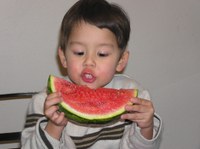N.D. Gardeners Test Veggie, Flower Varieties
(Click the image below to view a high-resolution image that can be downloaded)
You may want to thank your gardening neighbors if the vegetables or flower you grow produce well.
Gardeners across North Dakota are testing vegetable and cut-flower varieties to help determine which grow best in their area. These gardeners are part of a grass-roots variety selection program Tom Kalb started in 2008. He is the North Dakota State University Extension Service’s horticulturist for western North Dakota.
The program is revolutionizing the variety testing process in North Dakota. Traditionally, testing occurs in research station fields. But those fields don’t mimic the conditions in home gardens, Kalb says. Home gardeners may have trees and buildings that shade their gardens, and they don’t have hired help to weed or fertilize the gardens or overhead irrigation systems.
“If we want to identify the best varieties for gardens, we have to test the varieties in gardens,” he says.
Ninety-five families participated in the program the first year. That number skyrocketed to about 350 in 2009, making this the largest program of its kind in the nation.
“This program is great for those who enjoy gardening or have an interest to start gardening but just need the incentive to get going,” says Carrie Opdahl of Fessenden. Her family enrolled in the program in 2009 and tested purple and orange carrots, zucchini, cucumbers, spinach, lettuce, melons and peas.
Kalb hopes 500 families sign up this year.
“The more insights you have, the better it is,” he says.
The participants say the program has several benefits for them, too.
“It was a great experience for my entire family as we all tended the garden together, from planning the garden spot to sowing the seeds, to weeding, picking the produce and, of course, eating our rewards,” Opdahl says.
Gardeners can check out an online seed catalog to help them select from more than 100 varieties of vegetables and cut flowers. Once they make their selections, they’ll receive two packets of seeds for each variety they plan to test. One packet contains seed for a new variety and the other has seed for a standard variety. They also get labels to identify the rows of each variety, 10 feet of string to encourage them to plant at least a 10-foot row of each variety, and an evaluation form.
The form asks the growers to indicate which variety grew faster, produced more and tasted better; which variety they prefer; and whether they’d recommend a variety to other North Dakota gardeners.
“It was very interesting and surprising how different the varieties were,” says Melanee Pulver of Hazen. Pulver, along with her 5-year-old daughter, Lucy, tested purple carrots, peas, green beans, slicing and burpless cucumbers, and tatsoi (an Asian salad green) in 2009. “For instance, the Dakota pea and the other variety had completely different plants and pods.”
Kalb would like varieties tested for two years before passing judgment on them because weather conditions change from year to year, and a variety that didn’t grow well one year might flourish the next summer.
“But sometimes it’s obvious we have a winner, and sometimes it’s obvious we have a loser,” he says.
Anyone interested in participating in the program should contact Kalb at (701) 221-6865 or tom.kalb@ndsu.edu, or visit http://www.dakotagardener.com/trials/index.html.
Agriculture Communication
| Source: | Tom Kalb, (701) 221-6865, tom.kalb@ndsu.edu |
|---|---|
| Editor: | Ellen Crawford, (701) 231-5391, ellen.crawford@ndsu.edu |


